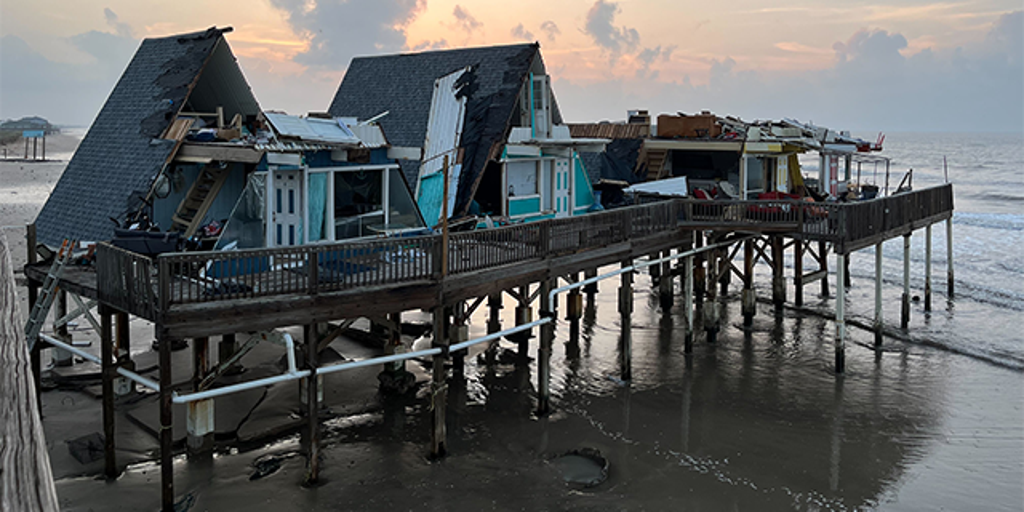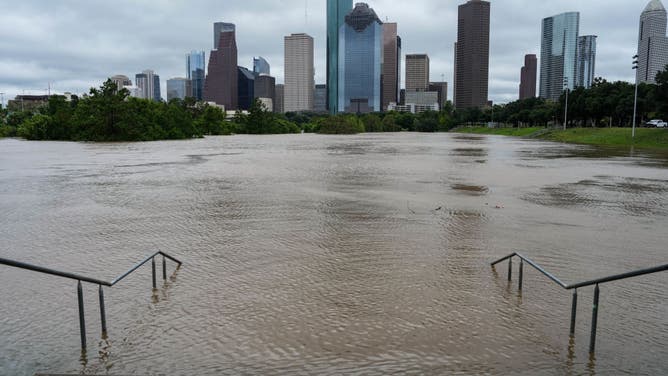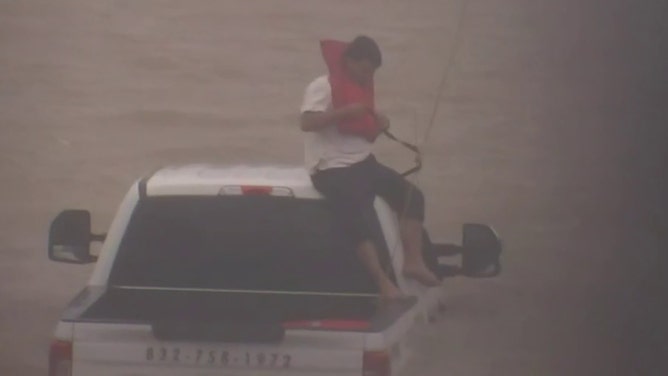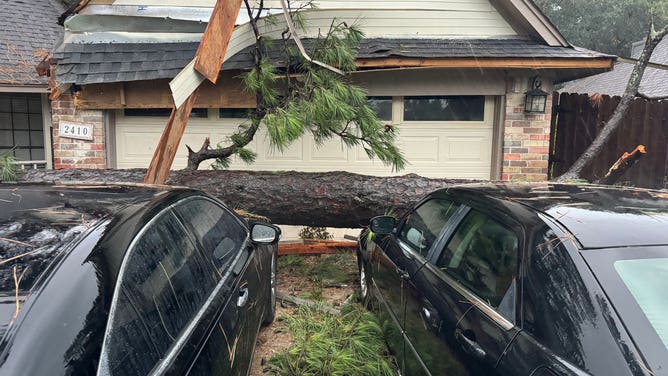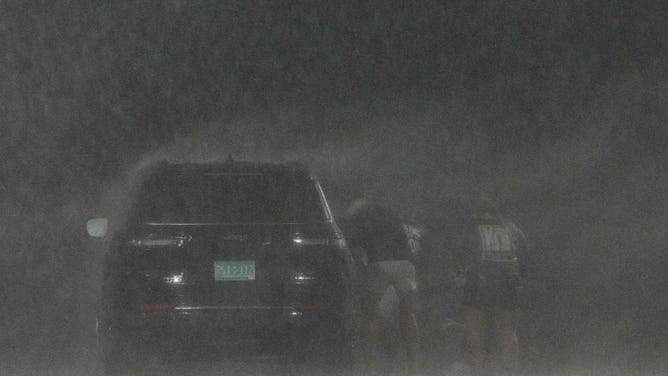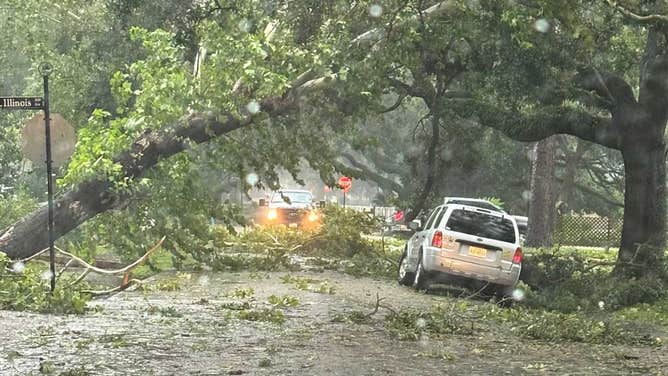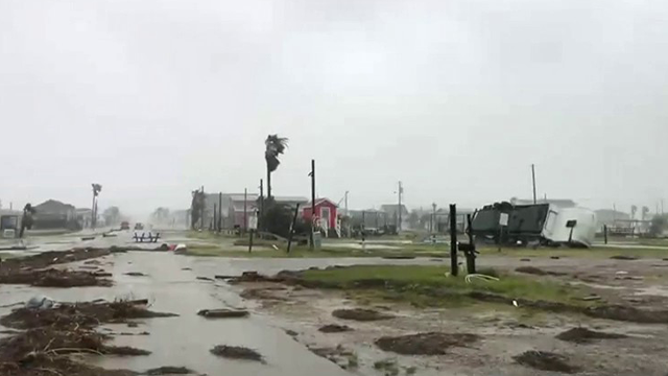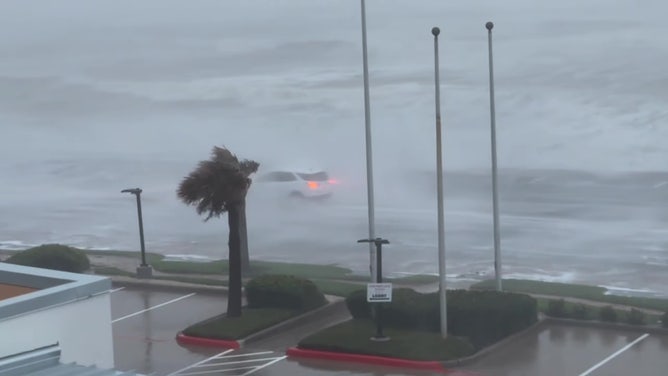Millions of people remain without power and at least seven people have been killed after Hurricane Beryl made landfall along the Texas coast on Monday and advanced inland, impacting communities across East Texas, including Houston.
HOUSTON – The sound of chainsaws and generators filled the air in communities across the Houston metro and East Texas one day after historic Hurricane Beryl made its third and final landfall, leaving behind 2.7 million outages and causing at least eight people deaths in the U.S.
Beryl roared ashore near the Texas city of Matagorda as a powerful Category 1 hurricane early Monday morning and pummeled the region with wind gusts higher than 90 mph, a 3-6 foot storm surge and torrential rain.

This image shows significant damage to a home in Surfside Beach, Texas, after Hurricane Beryl on July 9, 2024.
Damage is widespread, and Acting Texas Gov. Dan Patrick said his request for a Federal Emergency Disaster Declaration has been approved by Pres. Joe Biden.
“I’ve just spoken with President Biden,” Patrick said in a statement on X, formerly Twitter. “I’ve requested a federal emergency disaster declaration through FEMA to cover all costs for Category A (Debris) and Category B (Emergency Protective Measures). FEMA’s assistance with these costs will expedite the recovery process and help ensure the safety of Texans impacted by Hurricane Beryl. The president granted my request.”
The storm also spawned numerous tornadoes in Texas, Louisiana and Arkansas as it continued to advance inland.
WATCH: BERYL’S HURRICANE-FORCE WINDS CAUSE WIDESPREAD POWER OUTAGES, FLASH FLOODING IN TEXAS

This graphic shows heat alerts in effect across the Houston area and southeastern Texas on Tuesday, July 9, 2024.
(FOX Weather)
And the danger isn’t over in Texas.
Temperatures are expected to soar on Tuesday, with feels-like temperatures well above 100 degrees in many areas hit hard by the storm. The National Weather Service office in Houston issued a Heat Advisory for the region because of the widespread power outages and lack of air conditioning that will have people scrambling to find ways to stay cool.
The city of Houston has opened numerous cooling centers for people to cool off and prevent the potentially deadly effects of heat-related illnesses such as heatstroke and heat exhaustion.
PHOTOS: HURRICANE BERYL FLIPS SEMI-TRUCKS, KNOCKS OUT POWER AFTER TEXAS LANDFALL
At least 8 deaths in U.S. attributed to Hurricane Beryl
The effects of Hurricane Beryl have left at least eight people dead in two states, bringing the total number of fatalities along the storm’s track from the Windward Islands to the U.S. to at least 19.
Seven of the deaths in the U.S. were in the greater Houston area.
Video shows stranded drivers being rescued after major flooding in the wake of Hurricane Beryl in the Houston area on Monday, July 8, 2024.
Three of those deaths occurred due to fallen trees. Three people drowned, including a Houston Police Department information security officer, and FOX 26 Houston reports another person died in a fire that was believed to have ignited after lightning hit a home in Southeast Houston.
In Louisiana, officials said a woman was killed in the Benton area after a tree fell onto a woman’s home on Monday.
WATCH: MAN RESCUED AFTER STRANDED ON TOP OF TRUCK IN HOUSTON FLOODWATERS AS BERYL POUNDS TEXAS
Millions without power in Texas as cleanup begins

This graphic shows power outages in Texas from Hurricane Beryl on Tuesday, July 9, 2024.
(FOX Weather)
Utility crews have been making progress in restoring power to the 2.7 million customers that were plunged into darkness during the storm, but there’s still a long way to go.
More than 2.1 million Texans are still without power, and CenterPoint Energy said it hopes to restore power to 1 million of those customers by the end of the day on Wednesday.
But power can’t be restored until debris is cleared and conditions are safe for crews.
Homes destroyed, roads ripped apart
FOX Weather Meteorologist was able to tour a Surfside Beach, Texas, home, that suffered significant damage after Hurricane Beryl made landfall on Monday, July 8, 2024.
FOX Weather Meteorologist Britta Merwin was in Surfside Beach as Hurricane Beryl was making landfall on Monday morning.
She returned to the area on Tuesday and said it was difficult to do so because of the extensive damage across the region.
“There are police escorts. There are police barricades,” she said. “And driving the streets on the barrier island is treacherous. I can’t tell you how many times we came in. We had to turn around, find another direction because there’s chunks of road that are missing – specifically up by the water because we’re about three blocks from the Gulf of Mexico.”
TIME LAPSE VIDEO SHOWS BERYL’S APPROACH, ONSLAUGHT OF STORM SURGE FLOODING IN TEXAS
A city-wide curfew and a flash flood warning were in place for Bay City, Texas, for the evening of Sunday, July 7, and the morning of Monday, July 8, as Hurricane Beryl made landfall in the state. This footage was filmed by Chad Casey, who said that it was a
Merwin said she has seen massive boulders about two feet in diameter that were pushed 30 feet or more over the road and into homes in the area.
“I mean, that’s the power of the water,” she said.
Hurricane Beryl’s ferocious winds toppled trees across the region, with many falling onto homes and businesses and causing extensive damage, and many facilities will remain closed on Tuesday as damage is repaired and debris is cleared. College Station, Texas recorded a peak gust of 99 mph during Beryl with multiple gusts over 80 mph clocked across the Houston area.
DOWNLOAD THE FREE FOX WEATHER APP
Hurricane Beryl made landfall early Monday morning, bringing heavy rain and strong winds. Views from downtown Houston show both the rain and wind whip through the buildings.
Emergency officials also warned residents impacted by the storm to stay inside because of the dangerous conditions.
Schools, courthouses, all Port Houston terminals, and some medical facilities have also been closed across the area while cleanup continues.
In addition, METRO Houston said Park & Ride and METRORail service would remain suspended on Tuesday. However, several local bus routes would resume service early Tuesday morning.
Houston rocked by widespread power outages for second time this year
Millions in Texas remain without power in the wake of Hurricane Beryl, including the Houston area. And this is now the second time power has been knocked out across Houston. In May, a deadly derecho knocked out power after it blasted through the Bayou City. FOX 26 Houston Reporter Shelby Rose joined FOX Weather on Wednesday with the latest on cleanup operations in the wake of Hurricane Beryl.
As crews continue to spread out across the Houston area to clear debris and restore power, it’s bringing up memories of a similar event that occurred just two months ago.
In May, a line of severe thunderstorms swept across southeastern Texas and blasted the Houston area with destructive winds up to 100 mph that killed at least seven people and knocked out power to more than 1 million utility customers.
The National Weather Service called the event a derecho, which produces destructive winds for hundreds of miles.
During the derecho in Houston, winds blew out the windows of skyscrapers, sending shards of glass flying through the air and raining down on streets below. People rushed inside to seek safety as roofs were ripped from buildings and trees snapped like twigs.
Hurricane Beryl leaves behind extensive damage in Galveston
The Texas coast felt the worst of Hurricane Beryl as the storm roared ashore on Monday morning, including Galveston. FOX Weather Correspondent Katie Byrne was there as the storm tracked inland and spoke with residents about what they experienced and toured the damage left behind.
The Texas coast felt the brunt of Hurricane Beryl as the deadly storm made landfall and pushed inland, including the popular travel destination Galveston.
At the height of Hurricane Beryl, Galveston saw a top wind gust of 86 mph and recorded three straight hours of 70 mph gusts.
Storm surge flooding was also a major concern.
Measurements at Morgan’s Point along the shores of Upper Galveston Bay reached 5.4 feet above the mean high water level, which is now the third-highest surge on record. It also had the highest storm surge since it reached 7.78 feet during Hurricane Ike in 2008.
HURRICANE BERYL LEAVES TRAIL OF DAMAGE, WIDESPREAD POWER OUTAGES IN GALVESTON
Millions of utility customers in Texas remain without power after Hurricane Beryl made landfall early Monday morning, and now the cleanup efforts are underway. FOX News Multimedia Reporter Bowen Kedrowicz joined FOX Weather from Surfside Beach where residents are sorting through the debris in the wake of the deadly storm.
FOX Weather Correspondent Katie Byrne was in Galveston during the hurricane and saw extensive damage left behind when the storm moved out of the region.
She said she saw homes destroyed by Hurricane Beryl’s brutal winds as well as debris left scattered everywhere after floodwaters receded.
“There are pieces of house siding, overturned boats and debris scattered on roads nearby,” Byrne said. “While driving through Galveston Island, we saw dozens of downed power lines.”
Hurricane Beryl caused significant damage in Clute, Texas, including downed power lines, overturned 18-wheelers, damaged homes and businesses, flooded roads and extensive tree damage when it made landfall near Matagorda.
The neighborhood Byrne was in had been placed under a voluntary evacuation order – meaning several residents decided to hunker down and ride out the storm rather than seek shelter inland.
“I just sat there and watched everything,” resident Larry Shivers said. “It pushed my golf cart up underneath the house and up against a palm tree. It knocked my windshield out, and I found it out in the water.”
But through it all, he said he wasn’t scared.
“This is the second time I’ve been through it,” he said.
Beryl leaves deadly path of destruction across Caribbean
FOX Weather correspondent Robert Ray takes a video tour of the damage left behind in Jamaica after Hurricane Beryl lashed the island Wednesday.
Beryl’s third landfall in Texas culminated in a 10-day trek that began on June 29 in the Atlantic and spanned much of the Caribbean Sea, first smashing into the Windward Islands as a Category 4 hurricane.
It then swiped at Jamaica and the Cayman Islands as it crossed the Caribbean Sea and made a second landfall on Mexico’s Yucatán Peninsula as a strong Category 2 hurricane.
The hurricane left at least 11 people dead across the region as it made its historic trek across the open waters of the Atlantic and Caribbean.


